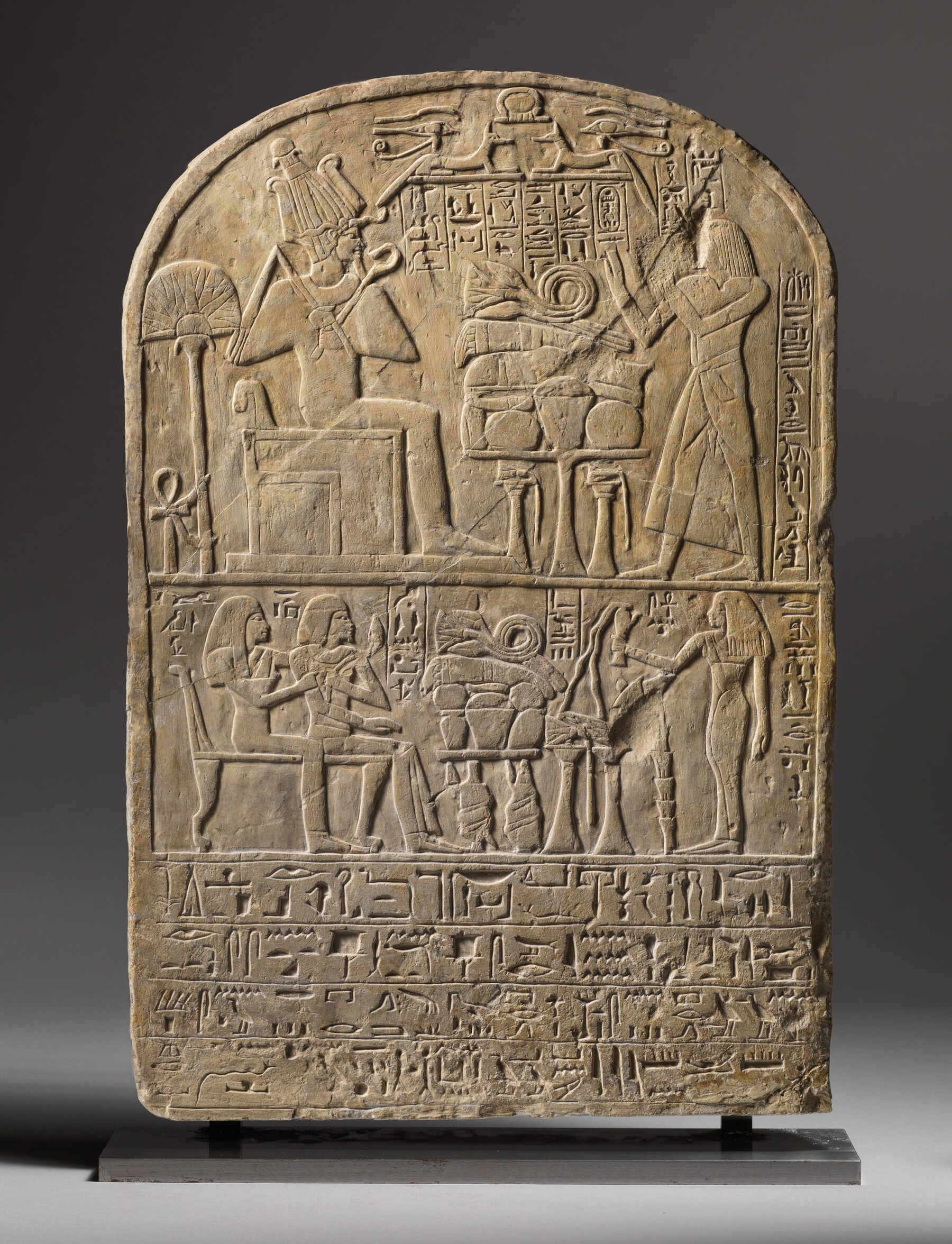Just as we do today, the ancient Egyptians named their boats. This round-topped stela belongs to a man named Smen, meaning “goose” in ancient Egyptian, who served on the royal state barge called Meryamun. He was promoted to standard bearer of the boat, “Menkheperure-destroys-Syria,” indicating he saw active military service during King Thutmose IV’s northern Syrian campaigns.1 In ancient Egypt, standard bearers could command troops and collect men for expeditions.2
On the top register, Smen praises Osiris-Wennefer, enthroned before an offering table piled high with bread, meat, fruit, and onions. The table and two braziers below are topped with lotus flowers, symbolizing eternity. Above, two Anubis jackals and udjat eyes face an encircling shen-ring. Osiris-Wennefer, the mummiform deity of the underworld, wears an Atef-crown and holds a crook and flail, his standard insignia. His block throne rests on the hieroglyph for ma’at, relating to his role as the judge of the dead. Behind the throne, an ankh sign holds an ostrich feather sunshade aloft, symbolizing the god’s divine presence.3 Smen wears a wig, a bag tunic, and a kilt tied with a sash. The column of text behind Smen gives his lineage, “born of the mistress of the house, Tjenna, and the dignitary Shemsu.” On the register below, his wife, Hesetre, makes a bouquet and libation offering to her deceased parents, Nakht and Rui, who are seated on a couch.4 Before them is an offering table loaded with the same provisions as above; the only difference is two containers of wine wrapped with lotus buds below the table. Below the second register are four rows of text, “(1) An offering which the king gives to Osiris, ruler of eternity, the great god, lord of Abydos, so that he may give a voice offering of bread [sic], beer, ox, fowl, and cold water, wine [sic], and (2) milk, breathe the sweet north wind, drink from […],(3) the receipt of the offerings that come forth in the presence of the choicest things that are issued on their altar, that one may come forth to me bearing […] (from among the offerings of the lord of)5 eternity, for the ka of the serviceman (w’w) (of the boat) Mery-Amun, (S)men.” Another stela belonging to Smen in the Louvre, mentions his son Nai.6
MH
-
Bryan, Betsy M. 1991. The Reign of Thutmose IV. Baltimore, MD: The Johns Hopkins Press, Ltd.. ↩︎
-
Schulman, Alan R. 1964. Military Rank, Title and Organization in the Egyptian New Kingdom. Münchner Ägyptologische Studien 6. Berlin: Hessling.. ↩︎
-
Hartwig, Melinda K. 2004. Tomb painting and identity in ancient Thebes, 1419-1372 BCE. Série IMAGO 2; Monumenta Aegyptiaca 10. Brussels; Turnhout: Fondation égyptologique Reine Élisabeth; Brepols.. ↩︎
-
PN I:221.2. ↩︎
-
Cf. Urk. V, 1629, 11. The fourth register is partly destroyed, and incorrect hieroglyphic signs were carved in modern times in the erased areas. Suggestions in parentheses here are based on the stela of Nebamun (Louvre C 60), who served as standard bearer for the royal barge (Bryan, Betsy M. 1991. The Reign of Thutmose IV. Baltimore, MD: The Johns Hopkins Press, Ltd.). ↩︎
-
Paris, Louvre C 202; Pierret, Paul. 1878. Recueil d’inscriptions inédites du Musée Égyptien du Louvre / traduites et commentées, Part 2. Études égyptologiques 8. Paris: Franck.. ↩︎
Bibliography
- Bryan 1991
- Bryan, Betsy M. 1991. The Reign of Thutmose IV. Baltimore, MD: The Johns Hopkins Press, Ltd.
- Hartwig 2004
- Hartwig, Melinda K. 2004. Tomb painting and identity in ancient Thebes, 1419-1372 BCE. Série IMAGO 2; Monumenta Aegyptiaca 10. Brussels; Turnhout: Fondation égyptologique Reine Élisabeth; Brepols.
- Pierret 1878
- Pierret, Paul. 1878. Recueil d’inscriptions inédites du Musée Égyptien du Louvre / traduites et commentées, Part 2. Études égyptologiques 8. Paris: Franck.
- Schulman 1964
- Schulman, Alan R. 1964. Military Rank, Title and Organization in the Egyptian New Kingdom. Münchner Ägyptologische Studien 6. Berlin: Hessling.
